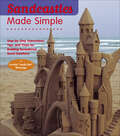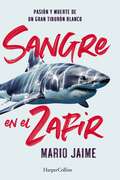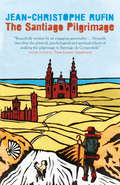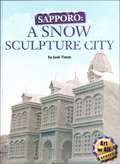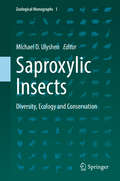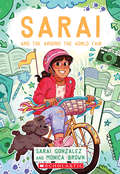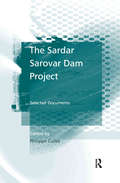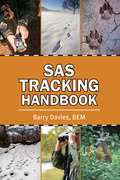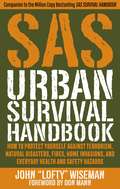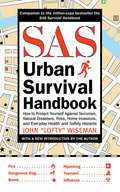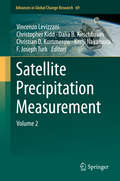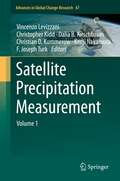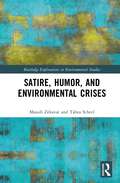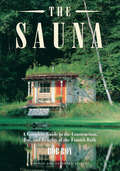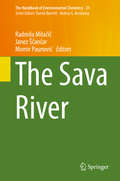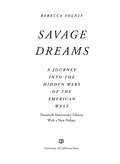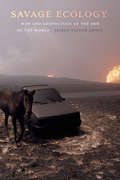- Table View
- List View
Sandcastles Made Simple: Step-by-Step Instructions, Tips, and Tricks for Building Sensational Sand Creations
by Lucinda WierengaA step-by-step guide to building elaborate and impressive sandcastles with a basic understanding of sand and a few simple tools. A crenellated turret here, a winding, arched staircase there, maybe even a giant turtle—fairy tale ideas are at the heart of every sandcastle. Summer after summer, children and adults alike make valiant efforts to infuse their sandy structures with such inspiration, but the results are generally disappointing. With Sandcastles Made Simple, Lucinda &“sandy feet&” Wierenga, a renowned sand sculptor, puts a permanent end to less-than-perfect beach creations. She provides the ultimate step-by-step guide to building impressive sandcastles, and shows that with a few simple tools and a basic understanding of sand, building dream castles can be easy. The book features instructions for each of the architectural elements—base, staircase, roof, balcony, and more—that can be combined to fashion one-of-a-kind castles. Also included are two projects designed specifically for younger children. Like a shovel and pail, Sandcastles Made Simple is an on-the-beach necessity.
Sangre en el Zafir: Las aventuras de un tiburón blanco
by Mario Jaime RiveraLa fascinante metáfora de Sangre en el Zafir te guiará por este espectacular viaje a las entrañas del inmenso mar, te convertirás en un enorme tiburón, ese ser espectacular y grandioso, cuya hambre por la supervivencia es tan colosal como su fuerza.Esta obra, que fue galardonada con el Premio Nacional de Novela Jorge Ibargu¨engoitia, narra la historia del representante de una especie que se encuentra seriamente amenazada por la depredación e ignorancia de su mayor enemigo: el ser humano.Blood on the ZafirThe fascinating metaphor of Sangre en el Zafir will guide you through this spectacular journey to the bowels of the enormous sea, you will discover yourself in a huge shark, that spectacular and great being, whose hunger for survival is as colossal as his strength.This work, awarded the Jorge Ibargüengoitia National Novel Prize, tells the story of the representative of a species seriously threatened by predation and ignorance of his greatest enemy: the human being.
The Sanitation Triangle: Socio-Culture, Health and Materials (Global Environmental Studies)
by Taro Yamauchi Seiji Nakao Hidenori HaradaThis open access book deals with global sanitation, where SDG 6.2 sets a target of enabling access to sanitation services for all, but has not yet been achieved in low- and middle-income countries. The transition from the United Nations MDGs to the SDGs requires more consideration based on the socio-cultural aspects of global sanitation. In other words, equitable sanitation for those in vulnerable situations could be based on socio-cultural contexts. Sanitation is a system that comprises not only a latrine but also the works for the treatment and disposal of human waste. Sanitation systems do not function by themselves but have significance only through social management. The process of decision-making also largely depends on socio-cultural conditions, and the importance of sanitation needs to be socially acknowledged. The health benefits of sanitation improvement—among the significant contributions of sanitation—also need to be considered in the socio-cultural milieu. Further, the social-culture itself is affected, and potentially even created, by sanitation. In this context, more progress on the improvement of sanitation requires a more holistic approach across disciplines.In this book, we present the concept of the Sanitation Triangle, which considers the interconnections of health, materials, and socio-culture in sanitation, as a holistic approach, and the case studies based on the Sanitation Triangle by diverse disciplines such as Cultural Anthropology, Development Studies, Health Sciences, Engineering, and Science Communication. By the deep theoretical examinations and inter-dialogues between the different disciplines, this book explores the potentialities of inter-disciplinary studies on global sanitation.
The Santiago Pilgrimage: Walking the Immortal Way
by Jean-Christophe Rufin"Whenever I was asked: 'Why did you go to Santiago?', I had a hard time answering. How could I explain to those who had not done it that the way has the effect - if not the virtue - to make you forget all reasons that led you to become involved in it in the first place."Each year, tens of thousands of backpackers (Christian pilgrims and many others) set out from either their front doorstep or from popular starting points across Europe, to Santiago de Compostela. Most travel by foot, others ride a bicycle, and a few of them travel as did some of their medieval counterparts, on horseback or with a donkey. In addition to those who undertake a religious pilgrimage, the majority are hikers who walk the way for non-religious reasons: travel, sport, or simply the challenge of spending weeks walking in a foreign land. Also, many consider the experience as a spiritual adventure, with a view to removing themselves from the bustle of modern life. Jean-Christophe Rufin followed this "Northern Way" to Santiago de Compostela by foot, on over eight hundred kilometers. Much less crowded than the usual pilgrimage route, this one runs along the Basque and Cantabrian coasts in Spain and through the wild mountains of Asturias and Galicia.Translated from the French by Malcolm Imrie and Martina Dervis
Sapporo: A Snow Sculpture City (Fountas & Pinnell LLI Gold #Level Q)
by Josh Timm<p>Freezing Fun <p>In northern Japan, the month of February is bleak--freezing, dark, and piled with snow. But one city has figured out a way to turn a dreary month into something magical. Every year, the city of Sapporo hosts a snow festival, which turns the city into a fantasyland, filled with huge snow sculptures, delicate ice statues, and warm friendships. <p> <p>Text Elements: <li>Genre: Nonfiction, Expository <li>Text Structures: Main: Categorical, Embedded: Temporal Sequence, Cause/Effect, Description <li>Text Features: table of contents, headings, photos, captions, labels, sidebars</li> </p>
Saproxylic Insects: Diversity, Ecology And Conservation (Zoological Monographs #1)
by Michael D. UlyshenThis volume offers extensive information on insect life in dying and dead wood. Written and reviewed by leading experts from around the world, the twenty-five chapters included here provide the most global coverage possible and specifically address less-studied taxa and topics. An overarching goal of this work is to unite literature that has become fragmented along taxonomic and geographic lines. A particular effort was made to recognize the dominant roles that social insects (e.g., termites, ants and passalid beetles) play in saproxylic assemblages in many parts of the world without overlooking the non-social members of these communities.The book is divided into four parts:· Part I “Diversity” includes chapters addressing the major orders of saproxylic insects (Coleoptera, Diptera, Hymenoptera, Hemiptera, Lepidoptera and Blattodea), broadly organized in decreasing order of estimated global saproxylic diversity. In addition to order-level treatments, some chapters in this part discuss groups of particular interest, including pollinators, hymenopteran parasitoids, ants, stag and passalid beetles, and wood-feeding termites.· Part II “Ecology” discusses insect-fungal and insect-insect interactions, nutritional ecology, dispersal, seasonality, and vertical stratification.· Part III “Conservation” focuses on the importance of primary forests for saproxylic insects, offers recommendations for conserving these organisms in managed forests, discusses the relationships between saproxylic insects and fire, and addresses the value of tree hollows and highly-decomposed wood for saproxylic insects. Utilization of non-native wood by saproxylic insects and the suitability of urban environments for these organisms are also covered.· Lastly, Part IV “Methodological Advancements” highlights molecular tools for assessing saproxylic diversity. The book offers an accessible and insightful resource for natural historians of all kinds and will especially appeal to entomologists, ecologists, conservationists and foresters.
Sara Snow's Fresh Living
by Sara SnowHost of the popular cable network programs "Living Fresh" and "Get Fresh with Sara Snow" brings her special blend of expert advice, enthusiasm, and realistic solutions to help readers make simple, practical changes with and for their families.
Sarai and the Around the World Fair (Sarai #4)
by Sarai Gonzalez Monica BrownFrom activist and viral video star Sarai Gonzalez!When Sarai outgrows her bike, she worries she'll never get to travel anywhere. But, when Martin Luther King Jr. Elementary hosts their first Around the World Fair, Sarai learns that with a little imagination, you can go anywhere you want!Inspired by the life of viral video sensation and social activist Sarai Gonzalez with the help of award-winning children's book author Monica Brown.
The Sardar Sarovar Dam Project: Selected Documents
by Philippe CulletThe Sardar Sarovar Project has been one of the most debated development projects of the past several decades at both an international level and within India itself. Cullet's volume brings together all the key documents relating to the project: including those pertaining to World Bank loans, the judicial pronouncements of the Supreme Court and documents relating to specific local level issues - in particular environment and rehabilitation. The work includes an introductory section focusing on the history of the project, the involvement of the different actors, the impacts on the local population, and a general analysis of the controversy surrounding it. In providing an easily accessible source for all the main documents relating to this landmark project, this compilation will be a valuable resource for researchers and policy-makers working in the areas of International Environmental Law and International Development Law.
SAS Survival Handbook, Third Edition
by John 'Lofty' WisemanThe ultimate guide to surviving anywhereUpdated to reflect the latest in survival knowledge and technology, and covering new topics such as urban survival and terrorism, the internationally bestselling SAS Survival Handbook is the definitive resource for all campers, hikers, and outdoor adventurers. From basic campcraft and navigation to fear management and strategies for coping with any type of disaster, this complete course includes:Being prepared: Understanding basic survival skills, like reading the weather, and preparation essentials, such as a pocket survival kit.Making camp: Finding the best location, constructing the appropriate shelter, organizing camp, staying warm, and creating tools.Food: What to eat, what to avoid, where to find it, and how to prepare it.First aid: A comprehensive course in emergency/wilderness medicine, including how to maximize survival in any climate or when injured.Disaster survival: How to react in the face of natural disasters and hostile situations--and how to survive if all services and supplies are cut off.Self-defense: Arming yourself with basic hand-to-hand combat techniques.Security: Protecting your family and property from intrusion, break-ins, and theft.Climate & terrain: Overcoming any location, from the tropics to the poles, from the desert to the mountains and sea.
SAS Tracking Handbook
by Barry DaviesTracking originated with man's need for food; he needed to understand what he was following and what the rewards would be if he was successful. Little has changed over time about the terms of tracking. We still track game for sport and food, but we have also found other uses for tracking. Border police patrol to stop illegal immigrants from entering their country; the military tracks down wanted terrorists or enemy forces. Tracking has become a military skill.In the SAS Tracking Handbook, former SAS soldier and British Empire Medal (BEM) award-winner Barry Davies teaches not only how to survive in the outdoors with the skills of tracking, but how to use these skills from a military standpoint.Included in this book are many helpful tips on topics including:The types of dogs used for tracking.Traps for catching wild animals.Modern military tracking.Using your surroundings to your advantage.And much more.The success or failure of the modern tracker is dependent on the personal skills of the individual tracker. Training is vital in learning tracking skills, and continuous exercise the best way to interpret signs. These skills are rarely found, but they remain hidden deep within all of us. So whether you're already a skilled tracker or a novice in the field, the SAS Tracking Handbook will be your guide to mastering this old and respected art.
SAS Urban Survival Handbook: How to Protect Yourself Against Terrorism, Natural Disasters, Fires, Home Invasions, and Everyday Health and Safety Hazards
by Don Mann John Lofty" WisemanJohn “Lofty” Wiseman is the author of the bestselling SAS Survival Handbook, the definitive guide to survival in the wild from Britain’s Special Air Service. Now he has compiled the complete guide to surviving among crowds of people, the mazes of office buildings, the dangers of an unfeeling city—put simply, how to stay safe in the urban jungle. <p><p> Thousands of preventable fatalities occur in the home every year—more than on the roads, more than in the great outdoors. Household chemicals, electricity, cooking knives, and rodent poisons—in the wrong hands and with improper usage, these day-to-day resources bring danger to your home. Add to this the risks of moving through city streets (the threat of rape, muggings, and gang violence) and the menace of natural disasters (floods, earthquakes, blizzards) that cannot be avoided. Every day serves as a constant reminder: The world is truly a frightening place. The SAS Urban Survival Guide advises readers to think practically about urban environments and offers tips and instructions on howto avoid hazards wherever one goes. From self-defense techniques to home security systems to coping with natural disasters, this book teaches readers to recognize danger, make quick decisions, and live confidently in the modern world.
SAS Urban Survival Handbook: How to Protect Yourself Against Terrorism, Natural Disasters, Fires, Home Invasions, and Everyday Health and Safety Hazards
by John Lofty" WisemanJohn "Lofty" Wiseman is the author of the bestselling SAS Survival Handbook, the definitive guide to survival in the wild from Britain's Special Air Service. Now he has compiled a complete guide to survival in the urban jungle. Every year in America there are thousands of fatal accidents in the home—more than on the roads, and many more than in the great outdoors. Fire, electricity, water, gas, sharp knives, poisons, chemicals—these valuable tools can quickly become dangerous weapons when not treated with proper respect and understanding. Add to these the risks of travel, terrorism, muggings, rape, tsunamis, and earthquakes. We are constantly reminded that the world is a dangerous place. Wiseman shows readers how to think realistically and practically about these perils in order to avoid them, whether they are at home, on the street, in school, or in transit. From self-defense techniques to home security systems to coping with natural disasters, this book will teach readers to recognize risks, make quick decisions, and live confidently in the modern urban world.
Satellite Precipitation Measurement: Volume 2 (Advances in Global Change Research #69)
by Vincenzo Levizzani Christopher Kidd Dalia B. Kirschbaum Christian D. Kummerow Kenji Nakamura F. Joseph TurkThis book offers a complete overview of the measurement of precipitation from space, which has made considerable advancements during the last two decades. This is mainly due to the Tropical Rainfall Measuring Mission (TRMM), the Global Precipitation Measurement (GPM) mission, CloudSat and a carefully maintained constellation of satellites hosting passive microwave sensors. The book revisits a previous book, Measuring Precipitation from Space, edited by V. Levizzani, P. Bauer and F. J. Turk, published with Springer in 2007. The current content has been completely renewed to incorporate the advancements of science and technology in the field since then. This book provides unique contributions from field experts and from the International Precipitation Working Group (IPWG).The book will be of interest to meteorologists, hydrologists, climatologists, water management authorities, students at various levels and many other parties interested in making use of satellite precipitation data sets.
Satellite Precipitation Measurement: Volume 1 (Advances in Global Change Research #67)
by Vincenzo Levizzani Christopher Kidd Dalia B. Kirschbaum Christian D. Kummerow Kenji Nakamura F. Joseph TurkThis book offers a complete overview of the measurement of precipitation from space, which has made considerable advancements during the last two decades. This is mainly due to the Tropical Rainfall Measuring Mission (TRMM), the Global Precipitation Measurement (GPM) mission, CloudSat and a carefully maintained constellation of satellites hosting passive microwave sensors. The book revisits a previous book, Measuring Precipitation from Space, edited by V. Levizzani, P. Bauer and F. J. Turk, published with Springer in 2007. The current content has been completely renewed to incorporate the advancements of science and technology in the field since then. This book provides unique contributions from field experts and from the International Precipitation Working Group (IPWG). The book will be of interest to meteorologists, hydrologists, climatologists, water management authorities, students at various levels and many other parties interested in making use of satellite precipitation data sets.
Satellite Remote Sensing for Conservation Action: Case Studies from Aquatic and Terrestrial Ecosystems
by Allison K. Leidner Graeme M. BuchananSatellite remote sensing presents an amazing opportunity to inform biodiversity conservation by inexpensively gathering repeated monitoring information for vast areas of the Earth. However, these observations first need processing and interpretation if they are to inform conservation action. Through a series of case studies, this book presents detailed examples of the application of satellite remote sensing, covering both aquatic and terrestrial ecosystems, to conservation. The authors describe how collaboration between the remote sensing and conservation communities makes satellite data functional for operational conservation, and provide concrete examples of the lessons learned in addition to the scientific details. The editors, one at NASA and the other at a conservation NGO, have brought together leading researchers in conservation remote sensing to share their experiences from project development through to application, and emphasise the human side of these projects.
Satellites in the High Country: Searching for the Wild in the Age of Man
by Jason MarkIn New Mexico's Gila Wilderness, 106 Mexican gray wolves may be some of the most monitored wildlife on the planet. Collared, microchipped, and transported by helicopter, the wolves are protected and confined in an attempt to appease ranchers and conservationists alike. Once a symbol of the wild, these wolves have come to illustrate the demise of wilderness in this Human Age, where man's efforts shape life in even the most remote corners of the earth. And yet, the howl of an unregistered wolf--half of a rogue pair--splits the night. If you know where to look, you'll find that much remains untamed, and even today, wildness can remain a touchstone for our relationship with the rest of nature. In Satellites in the High Country, journalist and adventurer Jason Mark travels beyond the bright lights and certainties of our cities to seek wildness wherever it survives. In California's Point Reyes National Seashore, a battle over oyster farming and designated wilderness pits former allies against one another, as locals wonder whether wilderness should be untouched, farmed, or something in between. In Washington's Cascade Mountains, a modern-day wild woman and her students learn to tan hides and start fires without matches, attempting to connect with a primal past out of reach for the rest of society. And in Colorado's High Country, dark skies and clear air reveal a breathtaking expanse of stars, flawed only by the arc of a satellite passing--beauty interrupted by the traffic of a million conversations. These expeditions to the edges of civilization's grid show us that, although our notions of pristine nature may be shattering, the mystery of the wild still exists -- and in fact, it is more crucial than ever. But wildness is wily as a coyote: you have to be willing to track it to understand the least thing about it. Satellites in the High Country is an epic journey on the trail of the wild, a poetic and incisive exploration of its meaning and enduring power in our Human Age.
Satire, Humor, and Environmental Crises (Routledge Explorations in Environmental Studies)
by Massih Zekavat Tabea ScheelSatire, Humor, and Environmental Crises explores how satire and humor can be employed to address and mitigate ecological crises at individual and collective levels. Besides scientific and technological endeavors, solutions to ecological crises must entail social and communicative reform to persuade citizens, corporations, organizations, and policymakers to adopt more sustainable lifestyles and policies. This monograph reassesses environmental behavior and messaging and explores the promises of humorous and satiric communication therein. It draws upon a solid and interdisciplinary theoretical foundation to explicate the individual, social, and ecospheric determinants of behavior. Creative works of popular culture across various modes of expression, including The Simpsons, Last Week Tonight with John Oliver, and The New Yorker cartoons, are examined to illustrate the strong if underappreciated relationship between humor and the environment. This is followed by a discussion of the instruments and methodological subtleties involved in measuring the impacts of humor and satire in environmental advocacy for the purpose of conducting empirical research. More broadly, the book aspires to participate in urgent cultural and political discussions about how we can evaluate and intervene in the full diversity of environmental crises, engage a broad set of internal and external partners and stakeholders, and develop models for positive social and environmental transformations. This book will be of great interest to students and scholars interested in environmental humanities, communication science, psychology, and critical humor studies. It can further benefit environmental activists, policymakers, NGOs, and campaign organizers.
Saudi Maritime Policy: Integrated Governance (Routledge Studies in Middle Eastern Politics)
by Tim Gray Hatim Al-Bisher Selina SteadBecause marine governance in most countries is sectoral, maritime policies are frequently fragmented, reactive, and even contradictory, meaning that marine resources are underutilized and poorly protected. To avoid these problems, the concept of integrated national maritime policy (INMP) has been developed. This book examines this concept, analysing its current application in four countries – Australia, Canada, UK and USA – whilst discussing at length how it might be applied to Saudi Arabia. Based on extensive fieldwork carried out in Saudi Arabia – including interviews with officials in government departments with maritime responsibilities, and a survey administered to 230 stakeholders – the book offers a unique insight into INMP in the Kingdom. The book provides a practical template for developing the political will and civil constituency in Saudi Arabia necessary for the introduction of INMP. In setting out in detail its benefits, this book could help build the momentum in Saudi Arabia required to implement the concept as well as attract other countries to do the same. A significant contribution to the growing literature on ocean governance, this book will be of great importance to policy makers and scholars of Middle Eastern studies, marine governance and comparative politics.
Sauna: The Power of Deep Heat
by Emma O'Kelly'This beautiful and timely book will appeal to anyone looking to deepen their experience, with or without the added joy of a cold swim.' Kate Rew, author of The Outdoor Swimmers' Handbook'An essential guide to a movement reborn, blending modernity and tradition, design and wellness, community and nature.' Sarah Douglas, editor in chief, Wallpaper magazineThere is a new wave of sauna culture spreading throughout the UK and beyond. Saunas are being built in unique settings providing tech-free spaces in which to gather, share stories and enjoy nature. The tradition has a rich history, filled with rituals that encourage us to soak up the mental and physical health benefits of deep heat.This book honours the old, embraces the new, and plunges headlong into the transformative power of steam.'Smartly written and beautifully illustrated ... a celebration of a cultural resurgence and a reminder of the power of connecting with nature and something larger than ourselves.' Mikkel Aaland, author of Sweat
The Sauna: A Complete Guide to the Construction, Use, and Benefits of the Finnish Bath, 2nd Edition
by null Robert L. RoyReplete with history, tradition, health benefits, instructions for proper use and maintenance, this completely revised and expanded edition will inspire!With a history going back at least one thousand years, the sauna is ready for a new generation of enthusiasts seeking health, pleasure, and peace of mind, and Rob Roy is ready to recruit! &“If the sauna is just a bath, then Buckingham Palace is just a house.&” So writes sauna expert and intrepid do-it-yourselfer Roy in this new, updated version of The Sauna.This completely revised and expanded edition of The Sauna contains everything you ever wanted to know about the famous &“Finnish bath.&” In this inviting book, Roy shares his infectious enthusiasm for the sauna and provides a complete, detailed guide to sauna building, along with resources for equipment and supplies.The Sauna is replete with history, tradition, health benefits, instructions for proper use and maintenance, as well as step-by-step instructions for building a variety of cordwood masonry saunas and, new to this edition, conventionally wood-framed saunas. The beautiful color photographs, also new to this edition, will inspire you to create your own sauna haven.
The Sava River
by Radmila Milačič Janez Ščančar Momir PaunovićThis volume provides a comprehensive overview of environmental aspects of the Sava River, which is the greatest tributary to the Danube River and the major drainage river system of South Eastern Europe. Hydroelectric power plants, river traffic, intensive agricultural activities, heavy industry and floods have considerable influence on the environment and biota in the basin. Summarizing the results that were gathered in the course of EU, bilateral and national projects, the book highlights the most important stressors and helps readers to better understand the impact of anthropogenic activities on the function of river basins. Topics include: transboundary water cooperation between the riparian countries; climate change projection, including its impact on flood hazards; evaluation of anthropogenic pollution sources; pollution of sediments, metal bioavailability and ecotoxicological and microbiological characterization of the river. The biological part also addresses quality aspects related to wildlife in river aquatic ecosystems (algae, macrophytes, zooplankton, macroinvertebrates and fish) and riparian ecosystems (amphibians, reptiles, birds and mammals). The general state of biodiversity and pressures caused by invasive aquatic species are also discussed.
Savage Dreams: A Journey into the Hidden Wars of the American West
by Rebecca SolnitSolnit offers a first-person account of her expeditions in California and Nevada, focusing on the politics and history of the Nevada Test Site and Yosemite National Park. She explores the connections between the political history of the West and its cultural history, which has been obscured by the reality of the violent past. Solnit weaves the story of the Danns, two Western Shoshone sisters who have fought the US government in an effort to reclaim their ancestral lands, into her narrative.
Savage Dreams
by Rebecca Solnit"A beautiful, absorbing, tragic book."--Larry McMurtryIn 1851, a war began in what would become Yosemite National Park, a war against the indigenous inhabitants. A century later-in 1951-and a hundred and fifty miles away, another war began when the U.S. government started setting off nuclear bombs at the Nevada Test Site. It was called a nuclear testing program, but functioned as a war against the land and people of the Great Basin.In this foundational book of landscape theory and environmental thinking, Rebecca Solnit explores our national Eden and Armageddon and offers a pathbreaking history of the west, focusing on the relationship between culture and its implementation as politics. In a new preface, she considers the continuities and changes of these invisible wars in the context of our current climate change crisis, and reveals how the long arm of these histories continue to inspire her writing and hope.
Savage Ecology: War and Geopolitics at the End of the World
by Jairus Victor GroveJairus Victor Grove contends that we live in a world made by war. In Savage Ecology he offers an ecological theory of geopolitics that argues that contemporary global crises are better understood when considered within the larger history of international politics. Infusing international relations with the theoretical interventions of fields ranging from new materialism to political theory, Grove shows how political violence is the principal force behind climate change, mass extinction, slavery, genocide, extractive capitalism, and other catastrophes. Grove analyzes a variety of subjects—from improvised explosive devices and drones to artificial intelligence and brain science—to outline how geopolitics is the violent pursuit of a way of living that comes at the expense of others. Pointing out that much of the damage being done to the earth and its inhabitants stems from colonialism, Grove suggests that the Anthropocene may be better described by the term Eurocene. The key to changing the planet's trajectory, Grove proposes, begins by acknowledging both the earth-shaping force of geopolitical violence and the demands apocalypses make for fashioning new ways of living.
